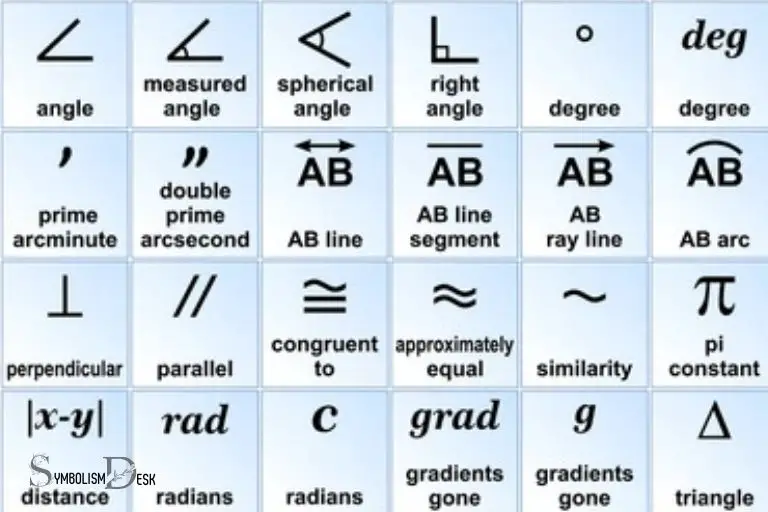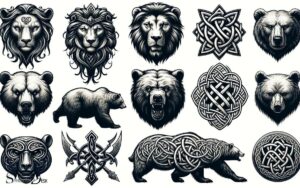What Does the Symbol Mean in Geometry? Characteristics!
The term “symbol” in geometry refers to a variety of signs or characters used to represent specific geometric concepts.
For example, parallel lines are represented by two vertical lines (||), a right angle is represented by a square corner, and congruency is represented by the equal sign with a squiggly line above it (≅).
In geometry, symbolic representation plays a crucial role in simplifying complex concepts and operations. Symbols provide an efficient way to express geometric properties without resorting to lengthy descriptions.
For instance, knowing that ‘||’ means parallel can save time when solving problems or proving theories involving parallel lines.
These symbols become universal language among mathematicians and scientists worldwide, promoting effective communication and understanding in these fields.
Regardless of one’s native language or country of origin, these symbols remain constant; their meanings unaltered.

10 Symbols and Their Meanings on Geometric
| Symbol | Definition |
|---|---|
| ∠ | Angle |
| ⊥ | Perpendicular |
| ∥ | Parallel |
| △ | Triangle |
| ⊆ | Subset |
| ∩ | Intersection |
| ∪ | Union |
| ∆ | Delta: Change in a variable |
| ≅ | Congruent to |
| ≈ | Approximately equal |
| ≠ | Not equal to |
| ≡ | Identical to |
| √ | Square root |
| π | Pi |
| ∑ | Sum |
| ∃ | There exists |
| ∀ | For all |
| ° | Degrees |
Geometry Symbols: Basic Categories And Descriptions
Geometry is the field of mathematics that studies shapes, sizes, positions, and orientation of objects in space.
Symbols used in geometry are pictorial representations of geometric concepts and relationships. In this section, we will explain the basic categories and descriptions of geometry symbols. Understanding circle triangle symbolism is essential in geometry as it helps to visually communicate ideas and mathematical relationships. Circles, for example, are commonly represented by the symbol “O” and triangles are often represented by the symbol “Δ”. By familiarizing oneself with these symbols, one can effectively interpret and solve geometric problems. It is important to understand the meanings and uses of these symbols in order to navigate the world of geometry with confidence.
Undefined Terms Symbols
Undefined terms are basic concepts like point, line, and plane in geometry that are not defined but only explained using examples.
Here are the symbols used in undefined terms:
- Point symbol (●): Represents a location in space without any dimension or size.
- Line symbol (←→): Represents a straight path that continues indefinitely in both directions.
- Plane symbol (⏤|⏤): Represents a flat surface whose boundaries extend indefinitely in all directions.
Defined Terms Symbols
Defined terms in geometry are basic concepts that are defined based on undefined terms.
Here are some of the symbols for defined terms:
- Angle symbol (∠): Represents the space between two intersecting lines or line segments measured in degrees.
- Line segment symbol (ab): Represents a part of a line with two endpoints a and b.
- Ray symbol (→): Represents a part of a line with one endpoint and extends indefinitely in one direction.
- Midpoint symbol (·): Represents the point that divides a line segment into two equal parts.
Congruence And Similarity Symbols
Congruence and similarity are two important concepts in geometry that describe how two shapes are related.
Here are the symbols used for congruence and similarity:
- Congruence symbol (≅): Represents that two shapes are identical in shape and size.
- Similarity symbol (∼): Represents that two shapes are the same in shape but different in size.
Polygons, Circles, And Curves Symbols
Polygons, circles, and curves are some of the common shapes studied in geometry.
Here are some symbols used to represent them:
- Polygon symbol (△abc): Represents a closed shape with three or more sides.
- Circle symbol (o): Represents a set of points that are equidistant from a fixed center point.
- Arc symbol (⌒): Represents a part of the circumference of a circle.
- Ellipse symbol (⨁): Represents a symmetrical shape that looks like a squashed circle.
Geometry symbols are an essential part of the language of geometry. With the help of these symbols, we can easily represent complex geometric concepts.
Understanding these symbols is crucial in solving geometric problems and mathematical equations.
Point, Line, And Plane Symbols
Geometry is a complex subject that requires understanding different symbols. These symbols represent different aspects, including points, lines, and planes.
Each symbol has its own definition, characteristics, examples, and applications. In this post, we’ll discuss the meanings of point, line, and plane symbols in geometry.
Understanding Point Symbols In Geometry
Points are the fundamental building blocks of geometry. Without them, the creation of more complex shapes and forms would be impossible. In geometry, points are denoted by symbols, which have certain characteristics.
Definitions And Characteristics
- A point is represented by a dot.
- It has no size, shape, or dimension.
- A point is named with a capital letter.
Examples And Applications
- The end-points of a line-segment are points.
- The vertices of a polygon are points.
- The intersections of two lines are points.
Understanding Line Symbols In Geometry
Lines represent straight paths that extend infinitely in both directions. They also have symbols that indicate their properties.
Definitions And Characteristics
- A line is represented by a straight horizontal line with an arrow at each end.
- It has no endpoints, width, or thickness.
- A line is named by two points on the line.
Examples And Applications
- The edges of a polygon are lines.
- The boundary of a circle is a line.
- The horizon is a line.
Understanding Plane Symbols In Geometry
Planes are flat surfaces that extend infinitely in all directions. They also have symbols unique to them.
Definitions And Characteristics
- A plane is represented by a parallelogram.
- It has two dimensions – length and width.
- A plane is named by any three points in the plane.
Examples And Applications
- The surface of a table is a plane.
- A wall is a plane.
- The floor in a room is a plane.
Understanding the symbols used in geometry is essential for solving problems and creating complex shapes.
Being familiar with the point, line, and plane symbols, along with their definitions, characteristics, examples, and applications, is crucial. As you progress with your geometry studies, you’ll become more confident and proficient in reading and utilizing these symbols.
Angle Symbols And Geometric Transformation Symbols
Defining Angle Symbols
Geometry is the branch of mathematics that deals with the study of shapes, sizes, positions, and dimensions of objects in space. It is essential to understand the language of geometry, especially the symbols used to represent angles.
Here are some key points to define angle symbols:
- An angle symbol represents the amount of rotation about a point.
- The symbol used to represent an angle is ∠.
- The measure of an angle is represented in degrees, radians, or as a fraction of a circle.
- Angles can either be acute, obtuse, right, straight, or reflex.
Basic Characteristics And Real-Life Representations
Angles are everywhere around us, and understanding the basic characteristics of angles can help us identify them in real-life representations.
Here are some key points to understand the basic characteristics of angles and their real-life representations:
- Angles can be formed by the intersection of two lines or the sides of a shape.
- The angles formed by two parallel lines and a transversal have specific relationships that can be used to solve problems.
- Angles are essential in trigonometry, architecture, and engineering, and they are used to measure distances in maps.
Applications And Functions Of Angle Symbols
Angle symbols have several applications and functions in different areas of life, including science, engineering, architecture, and mathematics.
Here are some key points to understand the applications and functions of angle symbols:
- Angle symbols are used in navigation to determine the direction of a ship or an airplane.
- In physics, angle symbols are used to represent torque, which is the rotational force that causes an object to rotate.
- In architecture, angle symbols are used to design buildings and structures with specific angles to enhance their aesthetic appeal.
Geometric Transformation Symbols
Geometric transformation symbols represent the transformation of a shape or an object. It is essential to understand these symbols as they are used in several areas of mathematics, including geometry, linear algebra, and physics.
Here are some key points to understand the geometric transformation symbols:
- Geometric transformation symbols include reflection, rotation, translation, dilatation, and shear.
- Reflection symbol is represented as an axis of symmetry separating the original figure and its mirror image.
- Rotation symbol is represented by an angle of rotation and a direction.
- Translation symbol is represented by a vector that specifies the direction and distance of the movement.
Reflection, Rotation, And Translation Symbols
Reflection, rotation, and translation symbols are essential in understanding the transformation of shapes and objects.
Here are some key points to understand these symbols:
- Reflection symbols are used to reflect an object over an axis of symmetry.
- Rotation symbols are used to rotate an object about a point or an axis.
- Translation symbols are used to move an object without changing its shape or size.
Understanding angle symbols and geometric transformation symbols is crucial in mathematics and its applications in different fields of life.
By understanding these symbols, we can solve mathematical problems, design structures, and navigate effectively.
Conclusion
As we have learned, symbols play a fundamental role in the study of geometry. They help us to communicate complex concepts and ideas quickly and efficiently.
Symbols are used to denote different types of geometric figures, including points, lines, and angles, among others.
By combining these symbols, we can create formulas and equations that allow us to solve even the most complicated geometric problems.
In addition, understanding the meaning of these symbols can open the door to a wide range of fields, from engineering and architecture to computer graphics and animation.
So, whether you are a student looking to ace your next geometry exam, or a professional hoping to leverage the power of geometry in your work, understanding the symbols of geometry is a crucial step toward success.






